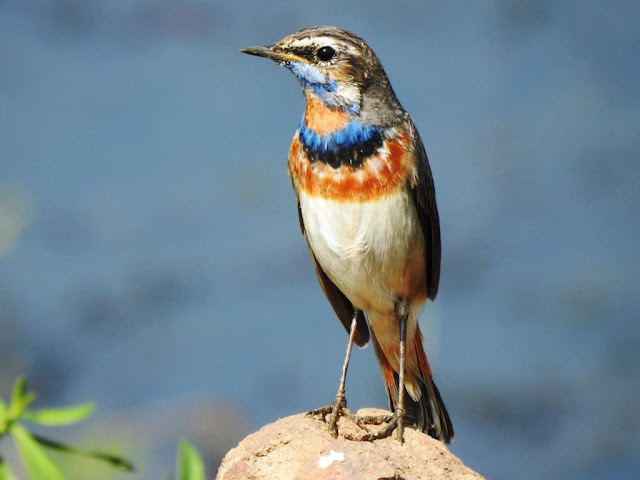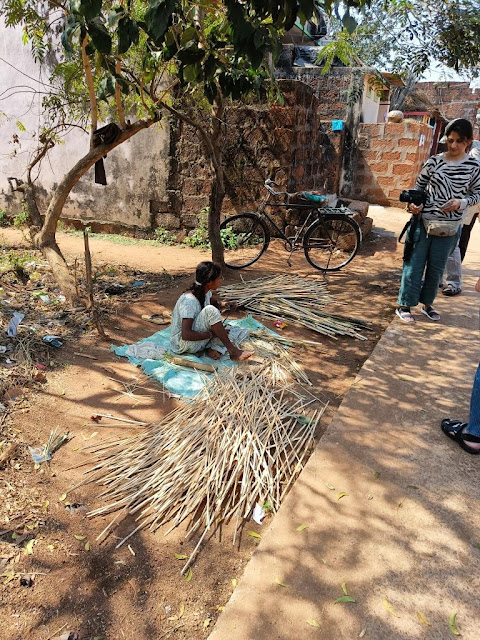For most of us, the word “Ghats” naturally refers to the Western Ghats extending from Mumbai Suburbs all along the western border of peninsular India right down to Kerala. Within these ranges nestle some wonderful forests, rivers and lakes that are home to an astonishing variety of avifauna ranging from fairy bluebirds to frogmouths.
This trip took us to the Eastern Ghats which are a somewhat
interrupted ridge of mountains and forest, running along the eastern edge of
the Indian Peninsula. These are, by all accounts, still to be explored fully
from a birding point of view.
Lying east of the ridge/forest of Khallikote about 70 Km south of Bhubaneshwar is the Chilika Lake.
 |
| Sunset@Mangalajodi |
As our aircraft on the Bhubaneshwar approach passed through a thin layer of clouds, we saw tops of mountains still sticking out, that represented the Eastern Ghats. As we made a perfect right bank and descended further, there appeared a huge thick forest, the Chandka forest, somehow miraculously standing firm right next to urban habitation.
Another obvious similarity with
the Western Ghats was that we were standing on the familiar laterite rock which
are used as building blocks and give rise to the reddish coloured dust.
 |
| Laterite rock |
The part of the lake that we visited at Mangalajodi was, however, neither a lake nor a mangrove forest that one might have expected to see near the sea. Chilika has been described as a “shallow estuary with large areas of mudflats”. Even the question of whether it is a freshwater lake or not, does not have a straight answer. Supposed to be fed by 90 rivers/rivulets, it has a connection to the sea. Therefore the southern parts are more brackish while the northern parts have sweet water. In fact when the easterly winds pick up, the water level in Mangalajodi (which is the northernmost corner) goes up and the water turns from sweet to brackish.
It occurred to more than one participant in our curious group to actually taste the water but we decided to take the word of our guide !!
Mangalajodi is apparently so called due to its twin Devi temples.
To conclude that the average person in Orissa is highly religious would not be an exaggeration. Throughout our stay we witnessed religious fervour of an intensity seldom witnessed even in a football match. The entire village had come alive with loudspeakers and pandals blaring chantings from early morning going into the wee hours of the night. Every house had made a rangoli outside with curious offerings kept on a brass lota decorated with mango leaves.
On the main road we also witnessed a group of women dressed in vibrant yellow red sarees, sporting the Vaishnavite symbol on the forehead, who were on a 150 Km trek in search of the Lords blessings.
We settled down in our homestay which is just at the edge of the Lake. The jetty point from where one embarks on the boat was only 5 minutes away by autorikshaws.
 |
| Sanjay Behera homestay |
 |
| The Jetty |
Next morning, we embarked from the designated Jetty which was about 2 Km from our homestay in the village. One could be forgiven for mistaking them for a Shikara, except that they were coloured green!! Since the water is only about knee deep at most, the boats are propelled by the bamboo pushing action of the boatman resulting in a gentle slow pace, ideal for watching birdlife. In fact being in the water at eye level renders a unique photographic perspective.
 |
| Eye level birding |
The birdlife is abundant and uniquely accessible as we made our way through the labyrinth of channels crisscrossing the marshland and mudflats. There were occasional patches with lush growth of reeds attracting the ubiquitous clamorous reed warbler and the occasional oriental reed warbler: the latter being recognized by its unique call.
 | ||||
| Clamorous reed warbler |
The waders gave excellent sightings including the long toed stint which was the subject of much of the post viewing discussions. Similarly animated was the differentiation between oriental and collared pratincoles causing disagreement even between our experts!!
 |
| Collared pratincole |
The ruffs which were in their hundreds, showed no sign of the fact that in a few months when they were back in China, they would morph into their dramatic breeding plumage and become clearly discernible as ruffs and reeves!
 | |||
| Ruff |
The greater painted snipe however had no such problem in proudly proclaiming that she was the torch bearer of the league of liberated avifauna wherein she would wear the attractive plumage and leave all parenting and related activities to the drab coloured male. One of the few examples of reverse gender dimorphism among birds.
 |
| Greater painted snipe female |
Other ducks sighted included the pintails, shovellers and a few spotbills, gargney and gadwall. Pied avocets and whiskered terns were also seen in good numbers. The brown headed gull also made an appearance.
 |
| Brown shrike |
 |
| Phesant tailed jacana non br |
 |
| Asian open billed stork |
 |
| Common snipe |
 |
| Greater coucal |
 |
| Bronze winged jacana |
 |
| Pintail duck male |
 |
| Grey headed lapwing |
 |
| Purple heron |
 |
| Whiskered tern |
 |
| Golden plover |
 |
| Barn swallow |
 |
| Spotted redshank |
 |
| Glossy ibis |
 |
| Black tailed godwit |
 |
| Marsh sandpiper |
Conspicuous by their absence were the raptors. Strangely they seem to avoid this land of plenty but are seen in large numbers in deserts where food is scanty! I assume there is a scientific explanation for this observation that is not so obvious.
However the rare appearance of the peregrine falcon did indeed set off a flight of frightened ducks that was a sight to behold. Also on display was the occasional marsh harrier and probably the eastern marsh harrier as well.
 |
| Pied avocet |
The unique geography of the marshland renders possible a strange event called action photography. We had dedicated an entire morning to this enterprise. In areas with relatively lowered water level, the large waders like black headed ibis, purple heron and grey heron are able to directly observe the watersnakes/eels.
As soon as they catch one, an elaborate feeding ritual commences wherein the snake , still wriggling, is swatted and tossed repeatedly so as to get a convenient head first hold. This continues for several long minutes before the hapless reptile is swallowed up. What results on the lake channels, is a spectacle similar to what is seen in Jungle safaris when a tiger is spotted by one of the jeeps.
All boatmen suddenly converge onto the site of “action” producing unexpected bursts of speed to afford the guests excellent close-up shots of the action. While this is an exercise involving a lot of waiting and patience, one can’t help wonder how suddenly the lowly “common” birds have become heroes of the action sequences.
 |
| Great egret |
 |
| Black headed ibis |
Also difficult to fathom is the expert birders obsession with differences in supercilium or trailing wings when spectacular specimens like this bluethroat were willing to oblige with liberal appearances in the bright sun! Reminded me of the time on my first trip to Eaglenest when I got admonished for running after the green tailed sunbird when a wernbabbler was calling from some dark obscure corner!!
 |
| Bluethroat |
Among various techniques of fishing that one might have come across over a lifetime, what we witnessed in Mangalojodi was most singular. Groups of fishermen waded in knee deep water carrying a purpose built wicker basket in each hand. With every step they would bear it down into the soft slush and carry on like this for hours on end. It appeared to be strenuous, painstaking and seemingly aimless work.
Except when, on an average three to four times in an entire day, a large fish gets trapped in the basket. The open hole on top is used to stick the hand inside and extricate the fish. This would still seem to be an unreasonably inefficient and uneconomical fishing technique, except when we are told that this particular 1-2 Kg fish sells for Rs 500 apiece!!
 |
| Basket fishing!! |
Everything in Mangalajodi was, understandably, about fish and fishing. We got a wonderful insight into the various fishing devices built from bamboo sticks and nylon netting during our village tour.
The entire family was engaged in this activity. We also visited one of the boat making yards where different sized boats made from cheap local wood were being crafted. Apparently they cost about Rs 20K and last about 2 years.
 |
| Boatmaking |
 |
| Fishing net making |
We were informed that this area was notorious for bird poachers who had drastically brought down the bird count some years ago. After intervention of some NGOs the villagers were convinced to allow the birds to exist in return for commercial benefits accruing out of increased ecotourism. Involvement of the Government was also visible in the form of restroom facilities near the jetty.
 |
| OTDC resort in the background |
While most of the birds seen at Mangalajodi would have been seen at Bharatpur or Jamnagar, each habitat is different and so is the experience. More importantly one gets to travel to different parts of this vast country, and connect with the real world even if fleetingly.
Having been brought up on stories of abject poverty in Orissa, one was pleasantly surprised to see hard working, well fed people celebrating the winter solstice festival of Rathasaptami with exuberance and pomp.
 |
| Mangalajodi villagers! |
Location: Village Mangalajodi, 70 Km south of Bhubaneshwar airport
Road condition: Excellent
Tour operator: Nature India https://natureindiatoursblog.wordpress.com
Lodging and Boarding: Sanjay Behera homestay
Camera: Nikon P900 and Oneplus Nord2
Dates: 05-08 Feb 2022
 |
| Odia thali |
 |
| The Group |












No comments:
Post a Comment